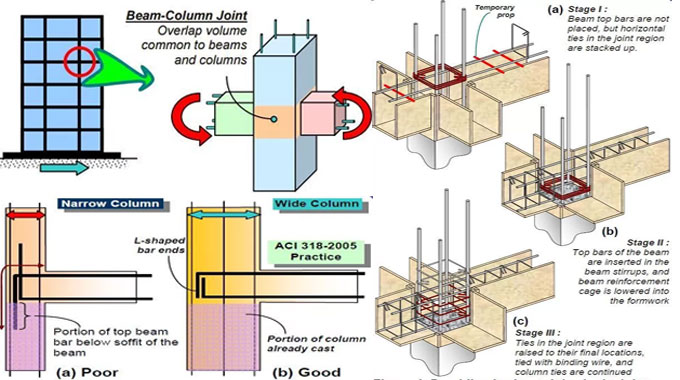NEWS | SOFTWARE | SHEET
In What Way Beam Column Joints opposes Earthquakes?
In reinforced concrete structures, parts of columns that are ordinary to beams at their junctions are named beam-column joints. As their integral constituents possess little strong points, the joints have inadequate force bearing capability. Once forces superior than these are used for the duration of earthquakes, joints are seriously disfigured.
Rectifying impaired joints is not easy, and therefore impairment has got to be prevented. Therefore, beam-column joints should be set to oppose earthquake outcomes.
Earthquake Performance of Joints: Following earthquake trembling, the beams neighboring a joint are controlled by moments in the equivalent (right-handed or anti-clockwise) direction.
In these instants, the highest bars in the beam-column joint are jerked in single direction and the substructure ones in the reverse direction. These forces are matched by bond pressure grown within concrete and steel in the joint area. In case, the column is not broad enough or in case the robustness of concrete in the joint is little, there is inadequate hold of concrete on the steel bars. In these conditions, the bar stumbles within the joint area, and beams lose their capability to bear load.
Strengthening the Beam-Column Joint: Slanted bursting and smashing of concrete in the joint area must be avoided to guarantee fine earthquake functioning of reinforced concrete frame buildings. Utilizing big column dimensions is the practically useful method of accomplishing this. Additionally, narrowly distanced closed-loop steel bonds are needed close to column bars to unite with concrete in joint area and to oppose shear forces. Central column bars also are useful in bounding the joint concrete and opposing horizontal shear forces.
Offering closed-loop links in the joint needs little additional attempt. Indian Standard IS: 13920-1993 suggests running the diagonal circles nearby the column bars about the joint area. In fact, this is accomplished through developing the enclosure of the reinforcement (both perpendicular bars and bolsters) of the entire beams at a floor height to be fixed at top of the beam frame of that height and reduced into the confinement. Though, this could not for all time be probable mainly once the beams are large and the whole reinforcement confinement turns out to be weighty.
Fixing Beam Bars: The hold of beam bars in the joint area is enhanced initially through utilizing columns of fairly huge cross-sectional magnitude. Indian Standard IS: 13920-1993 needs building pillars in seismic zones III, IV and V to be no less than 300 millimeter extensive in every direction of the sample once they hold up beams that are greater than 5 meter or once these columns are bigger than 4 meter amid floors (or beams).
The American Concrete Institute suggests a column breadth of no less than 20 times the width of largest perpendicular bar used in neighboring beam.

To get more information, go through the following link civilblog.org

